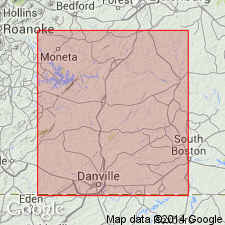
- Usage in publication:
-
- Cow Branch Member
- Modifications:
-
- Named
- Dominant lithology:
-
- Claystone
- Shale
- Siltstone
- AAPG geologic province:
-
- Piedmont-Blue Ridge province
Summary:
The Cow Branch Member of the Leakesville Formation is here named for discontinuous lenses, beds, and tongues of black and dark gray claystone, shale, siltstone, and sandstone containing organic debris in the Danville basin, VA. Intertongues with red beds of the Cascade Station Member of the Leakesville and with the arkosic facies of the Dry Fork Formation. Thickness at type section is 545 ft (165 m). Age is Late Triassic.
Source: GNU records (USGS DDS-6; Reston GNULEX).
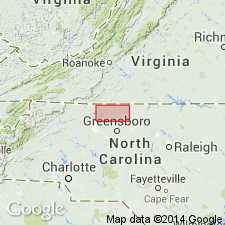
- Usage in publication:
-
- Cow Branch Formation
- Modifications:
-
- Revised
- AAPG geologic province:
-
- Piedmont-Blue Ridge province
Summary:
The Cow Branch Member of the Leakesville Formation of Meyertons (1963), named in the Danville basin, VA, is here revised as the Cow Branch Formation of the Dan River Group in the Dan River basin, NC. It consists of thinly laminated to massive siltstone, claystone, and shale with thin lenticular layers of coal in the lower 200 ft (60 m). It gradationally overlies the Pine Hall Formation and conformably underlies and intertongues with the Stoneville Formation of the Dan River Group. It crops out in a narrow belt along the southeast side of the basin. Thickness averages 600 ft (180 m). Reference sections are given. Age is Late Triassic.
Source: GNU records (USGS DDS-6; Reston GNULEX).
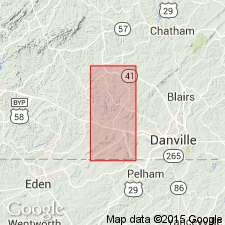
- Usage in publication:
-
- Cow Branch Formation
- Modifications:
-
- Revised
- AAPG geologic province:
-
- Piedmont-Blue Ridge province
Summary:
In the southwestern part of the Brosville quadrangle, Danville basin, Virginia, Triassic rocks are divided into the Pine Hall, Cow Branch, and Stoneville Formations. The Cow Branch forms the reference bed for this division of rocks. In parts of the area where the Cow Branch is absent there is no basis for distinguishing more than one unit, the Dry Fork Formation of Meyertons (1963), which is equivalent to the Pine Hall and Stoneville Formations. [No reference is made to the Leakesville Formation of Meyertons (1963), of which the Cow Branch was a member.]
Source: GNU records (USGS DDS-6; Reston GNULEX).
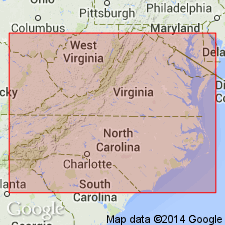
- Usage in publication:
-
- Cow Branch Formation
- Modifications:
-
- Age modified
- Biostratigraphic dating
- AAPG geologic province:
-
- Piedmont-Blue Ridge province
Summary:
The age of the Cow Branch Formation is late middle to late Carnian, based on pollen and spore assemblages. The underlying Pine Hall Formation is middle Carnian, the overlying Stoneville Formation is late Carnian, and the Dry Fork Formation is middle and late Carnian.
Source: GNU records (USGS DDS-6; Reston GNULEX).
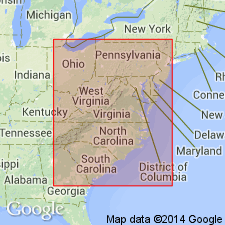
- Usage in publication:
-
- Cow Branch Formation*
- Modifications:
-
- Biostratigraphic dating
- AAPG geologic province:
-
- Piedmont-Blue Ridge province
Summary:
A new palynomorph species, FROELICHSPORITES TRAVERSEI, occurs throughout Newark Supergroup of eastern United States and Canada, Dockum Group of TX and NM, and Chinle Formation of NM, AZ, and UT. It is restricted geologically to strata deposited during upper Carnian and Norian Stages of the Upper Triassic. It occurs in the following formations of the Newark Supergroup: Passaic Formation (NJ), Gettysburg Formation (PA and MD), Manassas Sandstone (MD), Balls Bluff Siltstone (VA), Cow Branch Formation (NC), and Stoneville Formation (NC).
Source: GNU records (USGS DDS-6; Reston GNULEX).
For more information, please contact Nancy Stamm, Geologic Names Committee Secretary.
Asterisk (*) indicates published by U.S. Geological Survey authors.
"No current usage" (†) implies that a name has been abandoned or has fallen into disuse. Former usage and, if known, replacement name given in parentheses ( ).
Slash (/) indicates name conflicts with nomenclatural guidelines (CSN, 1933; ACSN, 1961, 1970; NACSN, 1983, 2005, 2021). May be explained within brackets ([ ]).

